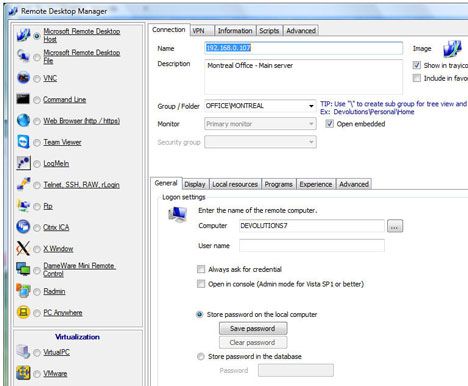

The burden is on the administrator to isolate those in various safes and to ensure that everyone’s account has the same keywords.
#Remote desktop manager devolutions password
Remote Desktop Manager uses the Privileged Account and launches either: a PSM Connection connects to the PVWA or even launches a session supported by Remote Desktop Manager, all the while still hiding the password from the user.ĬyberArk Application Access Manager (AAM) Configurationįirst, you must issue PKs for each of your users and deploy them to their workstations.

Remote Desktop Manager obtains the details of a Privileged Account, what is key is that the user does not know the password for their own privileged account.It’s configured as an Application object that is essentially a user proxy used to query the Vault. The PK is used to authenticate against the CyberArk Vault.When their Privileged Account is required to launch a supported technology, Remote Desktop Manager will obtain the appropriate Private Key from the workstation, it must be held in the certificate store for the user.The user is authenticated to Remote Desktop Manager with a Least Privilege Account, this gives them a view into the Remote Desktop Manager content as per the permissions set in our User Groups Based Access Control.OverviewĪ diagram is necessary to properly illustrate the solution. This module allows for Private Key (PK) authentication, which means that the whole Identification/Authentication phase is managed by your IT Department, rendering passwords completely unnecessary.Īlso, let’s start with a caveat that the password-less part is in regards to CyberArk, you still have to authenticate to Remote Desktop Manager, whatever datasource you are using. The only requirement is that you operate CyberArk's Application Access Manager (AAM) as part of your organization’s CyberArk deployment. Our third type is already available in Remote Desktop Manager 2020.3 beta, this completes the current round of improvements and essentially allows organizations to go password-less for their day-to-day workflows. Going password-less with Remote Desktop Manager and CyberArkĭuring the last few months, you may have noticed a heightened level of collaboration between Devolutions and CyberArk Indeed, two of our three entry types have been refreshed in version 2020.2 to better use their improved APIs.


 0 kommentar(er)
0 kommentar(er)
